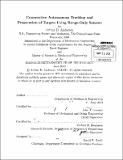Cooperative autonomous tracking and prosecution of targets using range-only sensors
Author(s)
Anderson, Arthur D., III (Arthur Douglas)
DownloadFull printable version (7.042Mb)
Other Contributors
Massachusetts Institute of Technology. Department of Mechanical Engineering.
Advisor
John J. Leonard and Michael R. Benjamin.
Terms of use
Metadata
Show full item recordAbstract
Autonomous platforms and systems are becoming ever more prevalent. They have become smaller, cheaper, have longer duration times, and now more than ever, more capable of processing large amounts of information. Despite these significant technological advances, there is still a level of distrust for the public autonomous systems. In marine and underwater vehicles, autonomy is particularly important being that communications to and from those vehicles are limited, either due to the length of the mission, the distance from their human operators, the sheer number of vehicles being used, or the data transfer rate available from a remote operator to an underwater vehicle through acoustics. The premise for this research is to use the MOOS-IvP code architecture, developed at MIT, to promote and advance marine vehicle autonomy collective knowledge through a project called Hunter-Prey. In this scenario, two or more surface vehicles attempt to cooperatively track an evading underwater target using range-only sensors, and ultimately maneuver into position for a "kill" using a simulated depth charge. This scenario will be distributed to the public through academic institutions and interested parties, who will submit code for the vehicles to compete against one another. The goal for this project is to create and foster an open-source environment where parties can compete and cooperate toward a common goal, the advancement of marine vehicle autonomy. In this paper, the Hunter-Prey scenario is developed, a nominal solution is created, and the parameters for the scenario are analyzed using regression testing through simulation and statistical analysis.
Description
Thesis (Nav. E. and S.M.)--Massachusetts Institute of Technology, Dept. of Mechanical Engineering, 2013. Cataloged from PDF version of thesis. Includes bibliographical references (p. 73-74).
Date issued
2013Department
Massachusetts Institute of Technology. Department of Mechanical EngineeringPublisher
Massachusetts Institute of Technology
Keywords
Mechanical Engineering.